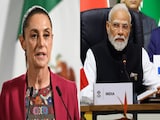IMF praised India for "right policies" to reduce debt; called China biggest contributer of global debt
New Delhi:
The International Monetary Fund or IMF has praised India for using "the right policies" to lower its level of debt. Highlighting India's debt to GDP ratio - the ratio between a country's government debt (a cumulative amount) and its gross domestic product or GDP (measured in years) - IMF said, India's share is "quite high", but New Delhi is trying to lower it using "the right policies."
At the same time the International Monetary Fund or IMF cautioned other major economies, especially China, saying public debt in advanced and emerging market economies are "currently at historic highs." The IMF advised major economies like China to "avoid policies that increase economic fluctuations."
Vitor Gaspar, Director of IMF Fiscal Affairs Department has advised countries to build strong public finances in good times in order to tackle looming risks.
Cautioning China
Mr Gasper pointed out that global debt reached a record high in 2016 at $164 trillion, or almost 225 per cent of global GDP. He noted that most of the debt is in advanced economies although in the last 10 years, emerging market economies like China have been responsible for most of the increase.
China alone, he said, has contributed to 43 per cent increase to global debt since 2007.
"Public debt is currently at historic highs in advanced and emerging market economies. Average debt-to-GDP ratios, at more than 105 per cent of GDP in advanced economies, are at levels not seen since World War II," Mr Gasper said at a news conference in Washington on Wednesday.
India Praised For "Right Policies"
Speaking at the same conference, Abdel Senhadji, Deputy Director of IMF's Fiscal Affairs Department praised India. He said, "India's general government debt remained relatively high, at 70 per cent of its GDP in 2017, but authorities are planning to bring it down over the medium term with the right policies."
India plans to continue with consolidation in the current fiscal year and over the medium term, the top IMF official said speaking about the financial or fiscal year 2017-18.
"They are, in fact, targeting their federal deficit of three per cent over the medium term, and they are also targeting a debt ratio of 40 per cent over the medium term at the federal level, which corresponds to about 60 per cent at the general government level. And we believe that those targets are appropriate," the IMF official said.
What is the debt to GDP ratio? How does it help?
Countries around the world depend heavily on sovereign debt to finance their economy and government. This borrowing or debt is generally used for funding projects and help the country modernise. It thereby helps the country grow faster than what it otherwise would have. But too much debt can lead to numerous problems. The debt to GDP ratio is an indicator to help investors determine the health of a country's economy and help assess if it has too much debt.
Is India's debt to GDP ratio worrisome?
Economic growth is a big factor is understanding whether a country's debt is a matter of worry or not. For economies that are growing rapidly, a higher debt to GDP ratio is acceptable. This is because its future earnings will be able to pay off the debt much more easily than a country with a slow growth rate. India on date is the world's fastest growing major economy. This coupled with multiple steps being taken by New Delhi to steadily decrease the debt to GDP ratio is a very good sign for an economy that is growing rapidly and steadily. Another factor that determines the health of an economy and its debt to GDP ration is its demographic. The older the average age of the countries population, greater the cause of concern. For example, an ageing population like China's is a cause of concern. India on the other hand has the world's youngest population.
RBI Report - June 2017
According to a release by the RBI in June last year, at the end of March 2017, India's external debt witnessed a decline of 2.7 per cent over its level at end-March 2016. The decline in the magnitude of external debt was partly due to valuation loss resulting from the depreciation of the US dollar with respect to the Indian rupee. The external debt to GDP ratio stood at 20.2 per cent at the end of March 2017, lower than its level of 23.5 per cent at the end of March 2016.
(With inputs from PTI)
At the same time the International Monetary Fund or IMF cautioned other major economies, especially China, saying public debt in advanced and emerging market economies are "currently at historic highs." The IMF advised major economies like China to "avoid policies that increase economic fluctuations."
Vitor Gaspar, Director of IMF Fiscal Affairs Department has advised countries to build strong public finances in good times in order to tackle looming risks.
Cautioning China
Mr Gasper pointed out that global debt reached a record high in 2016 at $164 trillion, or almost 225 per cent of global GDP. He noted that most of the debt is in advanced economies although in the last 10 years, emerging market economies like China have been responsible for most of the increase.
China alone, he said, has contributed to 43 per cent increase to global debt since 2007.
"Public debt is currently at historic highs in advanced and emerging market economies. Average debt-to-GDP ratios, at more than 105 per cent of GDP in advanced economies, are at levels not seen since World War II," Mr Gasper said at a news conference in Washington on Wednesday.
India Praised For "Right Policies"
Speaking at the same conference, Abdel Senhadji, Deputy Director of IMF's Fiscal Affairs Department praised India. He said, "India's general government debt remained relatively high, at 70 per cent of its GDP in 2017, but authorities are planning to bring it down over the medium term with the right policies."
India plans to continue with consolidation in the current fiscal year and over the medium term, the top IMF official said speaking about the financial or fiscal year 2017-18.
"They are, in fact, targeting their federal deficit of three per cent over the medium term, and they are also targeting a debt ratio of 40 per cent over the medium term at the federal level, which corresponds to about 60 per cent at the general government level. And we believe that those targets are appropriate," the IMF official said.
What is the debt to GDP ratio? How does it help?
Countries around the world depend heavily on sovereign debt to finance their economy and government. This borrowing or debt is generally used for funding projects and help the country modernise. It thereby helps the country grow faster than what it otherwise would have. But too much debt can lead to numerous problems. The debt to GDP ratio is an indicator to help investors determine the health of a country's economy and help assess if it has too much debt.
Is India's debt to GDP ratio worrisome?
Economic growth is a big factor is understanding whether a country's debt is a matter of worry or not. For economies that are growing rapidly, a higher debt to GDP ratio is acceptable. This is because its future earnings will be able to pay off the debt much more easily than a country with a slow growth rate. India on date is the world's fastest growing major economy. This coupled with multiple steps being taken by New Delhi to steadily decrease the debt to GDP ratio is a very good sign for an economy that is growing rapidly and steadily. Another factor that determines the health of an economy and its debt to GDP ration is its demographic. The older the average age of the countries population, greater the cause of concern. For example, an ageing population like China's is a cause of concern. India on the other hand has the world's youngest population.
RBI Report - June 2017
According to a release by the RBI in June last year, at the end of March 2017, India's external debt witnessed a decline of 2.7 per cent over its level at end-March 2016. The decline in the magnitude of external debt was partly due to valuation loss resulting from the depreciation of the US dollar with respect to the Indian rupee. The external debt to GDP ratio stood at 20.2 per cent at the end of March 2017, lower than its level of 23.5 per cent at the end of March 2016.
(With inputs from PTI)















